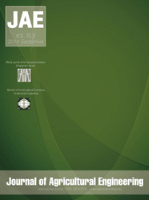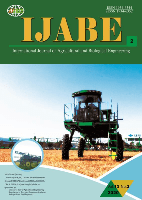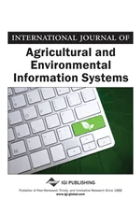
Journal of Agricultural Engineering
metrics 2024
Bridging Theory and Practice in Agricultural Engineering
Introduction
The Journal of Agricultural Engineering, published by PAGEPRESS PUBL, is a vital resource for researchers, professionals, and students engaged in the fields of agricultural technology and engineering. With an ISSN of 1974-7071 and an E-ISSN of 2239-6268, this Open Access journal has been disseminating valuable research since 2007, making significant strides in the accessibility of research findings. Based in Italy, the journal aims to bridge the gap between theoretical approaches and practical applications in agricultural engineering, focusing on innovative solutions to contemporary challenges in the sector. The journal has achieved respectable Scopus rankings, including #192/384 in Industrial and Manufacturing Engineering, highlighting its relevance and contribution to the field despite its Q4 and Q3 quartile rankings in related categories. The convergence of knowledge from 2012 to 2024 captures an evolving perspective on agricultural engineering practices, enhancing its appeal for those striving to advance the discipline. As an open-access platform, the journal ensures that cutting-edge research is readily available, fostering collaboration and knowledge sharing in a rapidly changing world.
Metrics 2024
 0.32
0.32 2.40
2.40 2.50
2.50 27
27Metrics History
Rank 2024
Scopus
IF (Web Of Science)
JCI (Web Of Science)
Quartile History
Similar Journals

Revista Brasileira de Engenharia Agricola e Ambiental
Exploring Cutting-Edge Practices in Agricultural EngineeringRevista Brasileira de Engenharia Agricola e Ambiental, published by the Universidade Federal de Campina Grande, serves as a pivotal platform for researchers and professionals in the fields of agricultural and biological sciences, agronomy, and environmental engineering. With an open-access policy since 2000, this journal aims to foster global dissemination of innovative research and practices, ensuring that high-quality findings are accessible to all. Operating in Brazil, it holds notable rankings, including Q2 in the categories of Agricultural and Biological Sciences (miscellaneous) and Agronomy and Crop Science, indicating its strong academic impact and influence within these fields. As of 2023, it ranks #68 out of 193 in Agricultural and Biological Sciences and #188 out of 406 in Agronomy and Crop Science, representing its commitment to advancing scientific knowledge. The journal primarily focuses on publishing studies that address challenges in agricultural engineering and environmental sustainability, making it an essential read for students, researchers, and professionals who are dedicated to innovation and excellence in these dynamic fields.

Journal of Central European Agriculture
Pioneering Research for Global Agricultural SolutionsThe Journal of Central European Agriculture, with ISSN 1332-9049 and E-ISSN 1332-9049, is an esteemed platform published by UNIV ZAGREB, FAC AGRICULTURE that caters to the dynamic fields of agronomy, crop science, and animal science. Since its establishment in 2000, this Open Access journal has played a crucial role in disseminating critical research findings while fostering collaboration among academics, researchers, and professionals within the agricultural community. The journal, which is based in the heart of Croatia, spans a rich history of scholarship, with its content available for free to readers and contributors alike. As reflected in its current standings, the journal has achieved a Quartile 3 ranking in Agronomy and Crop Science and Quartile 4 in Animal Science and Zoology for the year 2023, indicating its growing influence within these disciplines. With Scopus ranks placing it in the 32nd percentile among its peers, the Journal of Central European Agriculture is committed to advancing agricultural sciences not only in Central Europe but globally as it prepares for its converged years from 2007 through 2024. This journal serves as a vital resource for innovative research, practical applications, and a deeper understanding of agricultural challenges and solutions.

Transactions of the ASABE
Unveiling cutting-edge discoveries in agricultural sciences.Transactions of the ASABE is a premier journal published by the American Society of Agricultural and Biological Engineers, specializing in innovative research and practical applications in the fields of agricultural and biological engineering. With an ISSN of 2151-0032 and E-ISSN 2151-0040, this journal has established a vital niche in disseminating high-quality scholarly content that addresses the complex challenges faced in agriculture and biological systems. The journal operates under an open access model, facilitating broad dissemination of research findings to a global audience. This commitment to accessibility is reflected in its coverage of diverse topics, including agriculture, soil science, food science, and environmental engineering. Although the journal's coverage in Scopus was discontinued in 2021, it once ranked among the top in its categories, indicating its significant contribution to advancing knowledge in these essential fields. Researchers, practitioners, and students are encouraged to engage with the Transactions of the ASABE to stay abreast of developments and foster collaboration in promoting sustainable engineering solutions.

Agrosystems Geosciences & Environment
Championing open access to vital environmental research.Agrosystems Geosciences & Environment, published by WILEY, is a premier open access journal dedicated to advancing the interdisciplinary field of agricultural and environmental sciences. With an E-ISSN of 2639-6696, the journal has gained recognition since its inception in 2018, currently holding a Q2 ranking in Agricultural and Biological Sciences, Plant Science, and Soil Science. Operating from the United Kingdom, Agrosystems Geosciences & Environment contributes significantly to knowledge generation and dissemination, offering vital insights into sustainable practices, soil management, and crop optimization. Researchers and professionals will find the open access model particularly advantageous, promoting greater visibility and engagement within the scientific community. By bridging the gap between geosciences and agrosystem management, this journal is vital for those committed to addressing today's critical environmental challenges.

AMA-Agricultural Mechanization in Asia Africa and Latin America
Connecting Cultures Through Agricultural Mechanization InsightsAMA-Agricultural Mechanization in Asia Africa and Latin America is an esteemed journal published by the FARM MACHINERY INDUSTRIAL RESEARCH CORP, dedicated to advancing the field of agricultural mechanization. With a history spanning from 1982 to 2020, this journal has served as a pivotal platform for disseminating innovative research and insights related to agricultural practices and technologies across pivotal regions including Asia, Africa, and Latin America. Although the journal has ceased its coverage in Scopus, its contributions to the fields of Engineering and Agricultural and Biological Sciences remain significant, particularly for professionals and researchers focusing on agricultural engineering dynamics. While it operates under a traditional subscription model, the urgency of its content in mechanization solutions continues to aid in enhancing agricultural productivity and sustainability. Researchers and practitioners alike will find invaluable resources within its pages, reflecting the critical developments in the sector during the late 20th and early 21st centuries.

Journal of the ASABE
Driving Collaboration in Agricultural and Biological EngineeringJournal of the ASABE, published by the American Society of Agricultural and Biological Engineers, serves as a pivotal platform for disseminating cutting-edge research in various disciplines, including Agronomy, Crop Science, Biomedical Engineering, Food Science, Forestry, and Soil Science. With an impact factor that reflects its significance and reach, the journal ranks in the Q2 and Q3 quartiles across numerous categories in 2023, showcasing its commitment to advancing knowledge in agricultural and biological engineering. Authored by leading experts, the journal offers accessible articles on innovative methodologies, technologies, and sustainable practices essential to the global agricultural and environmental landscape. Open access options ensure that research findings are readily available to a broad audience, promoting collaboration and knowledge sharing among researchers, professionals, and students alike. With a strategic focus on research convergence into 2024, Journal of the ASABE is poised to shape the future of engineering solutions in agriculture and beyond.

International Journal of Agricultural and Biological Engineering
Connecting research and practice in agricultural engineering.Welcome to the International Journal of Agricultural and Biological Engineering, a premier open-access publication dedicated to advancing the fields of agricultural and biological engineering. Established and published by the Chinese Academy of Agricultural Engineering, this journal has been at the forefront of academic discourse since its inception in 2008. With an impact factor that reflects the journal's esteemed reputation, it ranks impressively in the Q2 category for both Agricultural and Biological Sciences and Engineering, showcasing its influence in these vital fields. The journal's commitment to innovation is underscored by its open-access model, ensuring that vital research is accessible to a global audience. Covering a diverse scope of topics relevant to the integration of engineering principles in agricultural practices, this journal is an essential resource for researchers, professionals, and students alike, providing insights that drive advancements and sustainable practices within the industry. With a dedicated editorial board and a rigorous peer-review process, the International Journal of Agricultural and Biological Engineering is poised to contribute significantly to the growth and development of knowledge in agricultural and biological systems.

AgriEngineering
Innovating Horticulture Through Cutting-Edge EngineeringAgriEngineering is a premier Open Access journal, published by MDPI, focusing on innovative research across the disciplines of agronomy, horticulture, food science, and engineering. Established in 2019 and headquartered in Basel, Switzerland, this journal has rapidly gained recognition, evidenced by its robust performance in the Scopus rankings and its positioning in Q1 and Q2 quartiles of key categories, including Horticulture and Agronomy. With a commitment to disseminating high-quality research that advances agricultural engineering practices, AgriEngineering provides a platform for researchers, professionals, and students to explore cutting-edge developments aimed at enhancing food production systems and sustainability. Its Open Access model ensures wide-reaching accessibility to vital research outcomes, empowering global collaboration and innovation in the field. For more information on submission and access, you can visit the AgriEngineering website.

AGRICULTURAL RESEARCH
Transforming agricultural practices through scholarly excellence.AGRICULTURAL RESEARCH is a distinguished academic journal published by SPRINGER INDIA, focusing on the dynamic fields of Agronomy, Crop Science, and Food Science. With an ISSN of 2249-720X and E-ISSN of 2249-7218, this journal has established itself as a valuable resource for researchers, professionals, and students dedicated to advancing agricultural knowledge and practices. The journal is recognized in the 2023 Scopus Rankings, achieving commendable quartile positions, including Q2 in Agronomy and Crop Science and Plant Science, as well as Q3 in Food Science, indicating its influential presence in the academic community. AGRICULTURAL RESEARCH aims to disseminate cutting-edge research findings, innovative methodologies, and comprehensive reviews, fostering collaboration and discussion among scholars in Switzerland and beyond. Through its commitment to scholarly excellence, this journal is pivotal in addressing contemporary challenges in agriculture, ensuring sustainability, and enhancing food security for the future.

International Journal of Agricultural and Environmental Information Systems
Cultivating Knowledge for Environmental and Agricultural ExcellenceInternational Journal of Agricultural and Environmental Information Systems, published by IGI Global, is a leading platform for scholarly discourse bridging the domains of agriculture, environmental science, and information systems. With its ISSN 1947-3192 and E-ISSN 1947-3206, this esteemed journal has been pivotal in tackling key information challenges within these crucial fields since its inception in 2010, and it continues to evolve until 2024. Featuring articles ranked in the Q3 category for Information Systems based on Scopus metrics— where it proudly stands at Rank #105 out of 394—this journal occupies a significant position in advancing knowledge dissemination and applied research. The open access option broadens the reach of its valuable content, making it accessible to a diverse audience. The journal's objective is to foster interdisciplinary research and innovations that enhance sustainability in agricultural practices and environmental management. By subscribing to the latest studies and innovations, researchers, professionals, and students can leverage the insights published in the International Journal of Agricultural and Environmental Information Systems to significantly contribute to their fields and foster better decision-making in environmental stewardship and agricultural advancements.